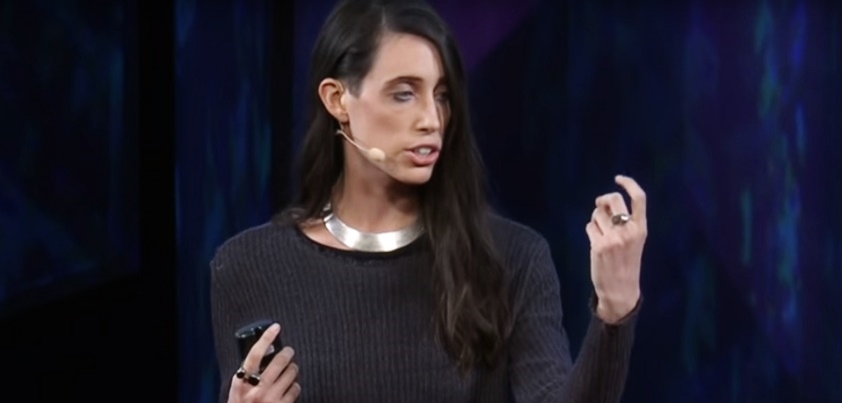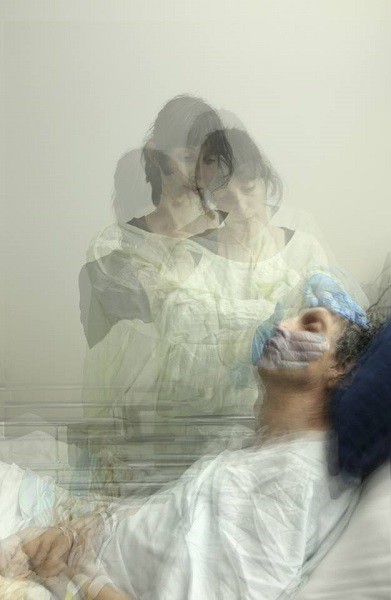写真家でアーティストで映像作家でもあるKitra Cahana キトラ・カハナさんが2014年におこなったスピーチ~My father, locked in his body but soaring free 閉じ込め症候群の父は、空を自由に舞う~ は、静かで感動的です。そして、これまでの固定観念をくつがえすパワフルなものでもありました。重い脳卒中をおこして、体の自由を失った自分の父について語っています。アイデアニュースではこれまでかっこちゃんこと山元加津子さんの本や、白雪姫プロジェクトのこと、指談筆談のことを紹介し、どんな人にも思いがあり、回復する可能性があるということを伝えてきました。言葉を伝える機能を失った家族の言葉を聞き取ろうとするキトラさんのやり方は、日本語で「あいうえお」を読み上げて合図を送ってもらう「あかさたなスキャン」と同じです。アルファベットを読み上げて、キトラさんが最初に受け取ったお父さんの美しい言葉を、みなさんもどうぞ英語で聞き取ってみて下さい。
In that ICU room, I walked up to my father’s body, and with a quivering voice and through tears, I began reciting the alphabet. A, B, C, D, E, F, G, H, I, J, K. At K, he blinked his eyes. I began again. A, B, C, D, E, F, G, H, I. He blinked again at the letter I, then at T, then at R, and A: Kitra. He said “Kitra, my beauty, don’t cry. This is a blessing.” There was no audible voice, but my father called out my name powerfully. Just 72 hours after his stroke, he had already embraced the totality of his condition. Despite his extreme physical state, he was completely present with me, guiding, nurturing, and being my father as much if not more than ever before.
その集中治療室で、私は父の体に近づき、震える声で涙を流しながらアルファベットを読み上げました。A, B, C, D, E, F, G, H, I, J, K. Kのところで父はまばたきをしました。またアルファベットを読み上げました。A, B, C, D, E, F, G, H, I. 今度はIのところでまばたき。そしてTで、それからRで、Aでまばたき。父はこう言ったのです。「キトラ、私の美しい娘よ、泣かないで。これは恵みなのだよ」 耳に聞こえる声ではありませんでしたが、父は私の名前を力強く呼んでくれました。発作から72時間しか経っていないのに、父はすでに自分の状況をすべて受け入れていたのです。肉体の極限状況にありながら、しっかりと私の側にいてくれました。導き、慈しみ、発作の前と比べて勝るとも劣らないくらい、完全に私の父であり続けてくれました。(翻訳:松中みどり)
単語がやや難しいかもしれませんが、有料部分にある語句解説を読んでから、ぜひ何度も聴いてみてください。
アートフォトグラファーでもある娘のキトラさんは、お父さんの病室に寝泊まりしリハビリを行いながら、どうしたらこの稀有の経験を写真に表現できるかを考えたそうです。キトラさんがアルファベットを読み上げ、お父さんがまばたきし、たくさんの言葉が紡がれました。「麻痺」と言っても、心臓は拍動し、血液は体を流れ、脳内を走る電気は光を放つ・・・どんな体の状態でも、完全なる麻痺などないから、キトラさんは、お父さんの写真をこんな風に撮影されたのです。ダイナミックに動く命を、静止した写真の中に表現しています。素晴らしい写真だと思います。
まばたき以外に意思を伝えることが出来ない麻痺の状態である「 locked-in syndrome : 閉じ込め症候群」に陥ることは、ほとんどの人にとって恐怖以外の何物でもないと思います。しかし、ユダヤ教の宗教指導者であるキトラさんの父ロニーさんは、これは、外部の喧騒から離れ、自分の心の奥に分け入ることが出来る「神の恵み」だと受け取りました。そして、アルファベットをささやく家族にまばたきをすることで、一文字一文字が言葉になり、意思になり、人々を導く説話になっていったのでした。
キトラさんのスピーチの全体はこちらです。
———————————
<アイデアニュース有料会員向けコンテンツ>
【語句解説】
フランス語では”maladie de l’emmuré vivant.” =”walled-in-alive disease.” 生きながら壁に閉じ込められる病
アートフォトグラファーとして父の姿をスピリチャルな写真に収める
【語句解説】
☆quiver (動)揺れる、震える cf. with a quivering voice and through tears, 震える声で、涙を流しながら
☆recite (動) 暗唱する 朗読する cf. My brother recited a poem. 弟は詩を暗唱した。
☆blink (名・動)まばたきする cf. 類語に wink がありますが、片方の目でblinkをして合図をすることがwink というわけです。
☆audible (形) 聞こえる、聞き取れる cf. audible voice 聞き取れる声
☆stroke (名) 発作、卒中 cf. apoplexy 卒中, infarction 梗塞
☆embrace (動) 抱きしめる、含むなどの意味がある動詞ですが、ここでは「受け入れる、歓迎する」という訳が適切な気がします。 Just 72 hours after his stroke, he had already embraced the totality of his condition. 「脳卒中になって、まだ72時間という時に、父はすでに自分の状態をすべて受け入れていたのです」
☆psyche (名) 魂、精神、心
☆ as much ちょうどそれだけ、同じように
フランス語では”maladie de l’emmuré vivant.” =”walled-in-alive disease.” 生きながら壁に閉じ込められる病
Locked-in syndrome is many people’s worst nightmare. In French, it’s sometimes called “maladie de l’emmure vivant.” Literally, “walled-in-alive disease.” For many people, perhaps most, paralysis is an unspeakable horror, but my father’s experience losing every system of his body was not an experience of feeling trapped, but rather of turning the psyche inwards, dimming down the external chatter, facing the recesses of his own mind, and in that place, falling in love with life and body anew
☆psyche (名) 魂、精神、心 cf. turning the psyche inwards 心を内側に向ける
☆dim down 次第に弱くする cf. dimming down the external chatter 外部の雑音を遮断していく
☆chatter (名) おしゃべり キーキー cf. 類語にchat という言葉がありますが、chatterの方が、音の大きい、うるさい、という感じが加わります。chat 談笑 chatter けたたましいおしゃべり、という感じでしょうか。
☆recesses (名) 奥まったところ cf. facing the recesses of his own mind 自分の心の奥と向き合う
アートフォトグラファーとして父の姿をスピリチャルな写真に収める
As a documentary photographer, I felt the need to photograph each of his first movements like a mother with her newborn. I photographed him taking his first unaided breath, the celebratory moment after he showed muscle resistance for the very first time, the new adapted technologies that allowed him to gain more and more independence. I photographed the care and the love that surrounded him.
☆unaided breath 独力での呼吸、自発呼吸
☆celebratory moment お祝いの瞬間
But my photographs only told the outside story of a man lying in a hospital bed attached to a breathing machine. I wasn’t able to portray his story from within, and so I began to search for a new visual language, one which strived to express the ephemeral quality of his spiritual experience.
☆ strive ~しようと努力する strive の過去形はstrove でも strived でもOKです。
☆ephemeral(形) つかのまの はかない
———————————
- YouTubeで学ぶ英語:(108)これからもYouTubeで学習を続けてください 2021年12月25日
- YouTubeで学ぶ英語:(107)インドネシア・ジャワ島のスメル火山が噴火 2021年12月11日
- YouTubeで学ぶ英語:(106)性被害告発後の中国テニス選手、真実はどこに 2021年11月27日

